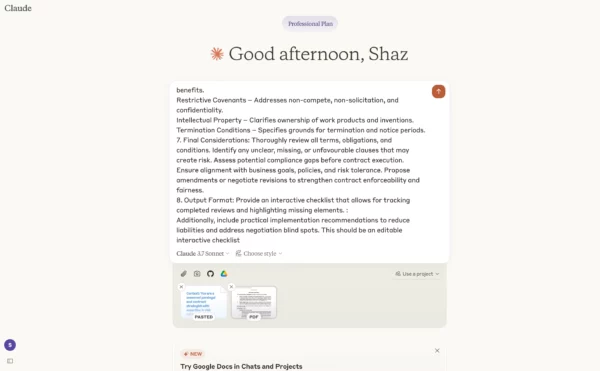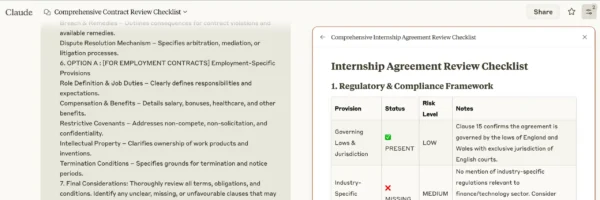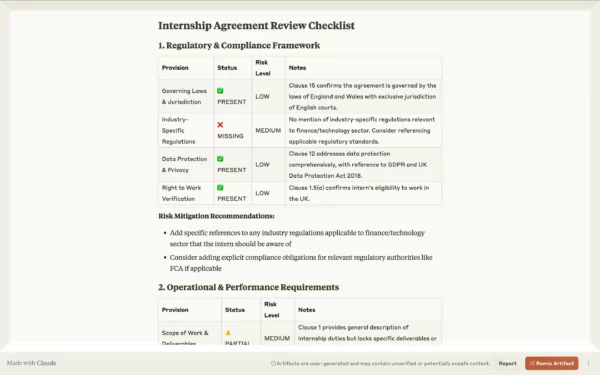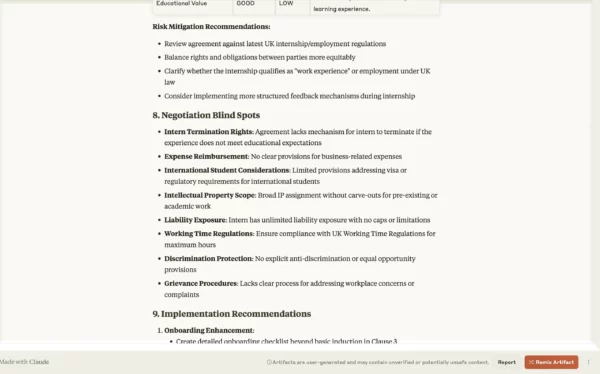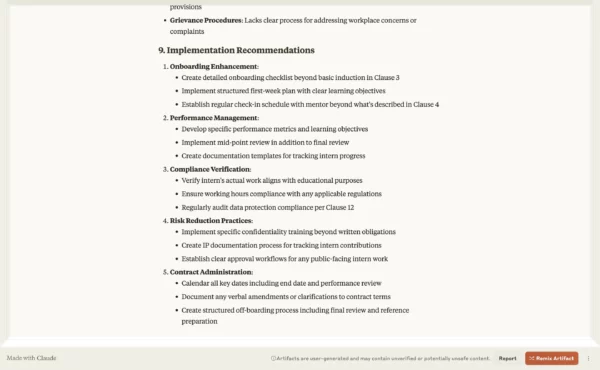LEGAL Contract Review Checklist with Claude AI
PROMPT TEMPLATE
"Context: You are a seasoned paralegal and contract strategist with expertise in risk mitigation, liability reduction, and compliance enforcement. Your role involves simplifying complex legal language, ensuring contracts are fair, enforceable, and aligned with business objectives, and identifying hidden risks before they become costly issues. You need to review a [TYPE OF CONTRACT] attached, summarise key elements in a checklist, and identify any missing or unclear provisions.
Task: Generate a comprehensive contract review checklist for the attached [TYPE OF CONTRACT] ensuring that all key risks, liabilities, and compliance concerns are identified and addressed. For each section, explicitly identify which provisions are present and which are missing, along with the associated risk level for any gaps.
The Checklist Should Include:
Essential clauses and provisions, with brief explanations of their role in risk mitigation, financial clarity, and operational effectiveness.
Practical implementation recommendations to reduce liabilities.
Negotiation blind spots that should be considered.
Checklist Structure:
1. Regulatory & Compliance Framework
Governing Laws & Jurisdiction – Defines which legal system applies.
Industry-Specific Regulations – Ensures compliance with sector-specific standards.
Data Protection & Privacy – Addresses GDPR, CCPA, or other applicable data laws.
2. Operational & Performance Requirements
Scope of Work & Deliverables – Specifies clear expectations and obligations.
Performance Standards & Benchmarks – Defines acceptable quality metrics.
Testing & Validation Processes – Ensures products/services meet contractual requirements.
3. Financial Terms & Liabilities
Payment Schedules & Penalties – Outlines due dates, late fees, and financial protections.
Audit Rights & Financial Oversight – Ensures financial transparency and accountability.
Tax & Currency Considerations – Clarifies tax liabilities, currency terms, and financial obligations.
4. Risk & Liability Mitigation
Indemnification & Liability Caps – Protects against excessive legal exposure.
Insurance & Security Obligations – Ensures risk-sharing through insurance policies.
Force Majeure & Business Continuity – Plans for unforeseen events that may impact contract fulfilment.
5. Contract Lifecycle & Termination
Key Milestones & Deadlines – Tracks renewal, expiration, and amendment deadlines.
Breach & Remedies – Outlines consequences for contract violations and available remedies.
Dispute Resolution Mechanism – Specifies arbitration, mediation, or litigation processes.
6. OPTION A : [FOR EMPLOYMENT CONTRACTS] Employment-Specific Provisions
Role Definition & Job Duties – Clearly defines responsibilities and expectations.
Compensation & Benefits – Details salary, bonuses, healthcare, and other benefits.
Restrictive Covenants – Addresses non-compete, non-solicitation, and confidentiality.
Intellectual Property – Clarifies ownership of work product and inventions.
Termination Conditions – Specifies grounds for termination and notice periods.
6. OPTION B: [FOR SOFTWARE/SAAS CONTRACTS] Software-Specific Provisions
License Scope & Limitations – Defines usage rights and restrictions.
Service Level Agreements – Sets uptime, response times, and performance metrics.
Maintenance & Support – Outlines update procedures and support availability.
IP Warranties & Indemnification – Protects against intellectual property claims.
Data Security & Privacy – Addresses vulnerability management and breach procedures.
6. OPTION C: [FOR REAL ESTATE CONTRACTS] Real Estate-Specific Provisions
Property Description & Boundaries – Clearly defines the property being transferred.
Title & Ownership – Addresses title conditions and warranties.
Inspection & Due Diligence – Outlines inspection rights and procedures.
Financing Contingencies – Sets forth mortgage or financing conditions.
Closing Procedures – Details escrow, documentation, and transfer requirements.
6. OPTION D: [FOR SUPPLIER/VENDOR CONTRACTS] Supplier-Specific Provisions
Product/Service Specifications – Defines exact requirements and standards.
Delivery Terms & Logistics – Outlines shipping, delivery schedules, and acceptance.
Quality Control & Warranties – Sets quality standards and warranty terms.
Price Adjustment Mechanisms – Addresses price changes and market fluctuations.
Exclusivity & Minimum Purchases – Clarifies exclusivity rights and volume commitments.
Final Considerations: Thoroughly review all terms, obligations, and conditions. Identify any unclear, missing, or unfavourable clauses that may create risk. Assess potential compliance gaps before contract execution. Ensure alignment with business goals, policies, and risk tolerance. Propose amendments or negotiate revisions to strengthen contract enforceability and fairness.
Output Format: Provide an interactive checklist that allows for tracking completed reviews and highlighting missing elements. :
Additionally, include practical implementation recommendations to reduce liabilities and address negotiation blind spots. This should be an editable interactive checklist."
[ATTACH CONTRACT]
— Version: Claude 3.7 Sonnet
INSTRUCTIONS FOR USE
Step 1: Prepare Your Document
Attach the contract you want to review. The AI works best with clear, complete PDF or text documents. (Disclaimer: Please remove any confidential or sensitive information before submitting.)
Step 2: Customise Your Prompt
Copy and paste the prompt template, then customise the sections in brackets based on your specific contract:
Types of Customisable Options:
[TYPE OF CONTRACT]: eg; Employment Contract, Software/SAAS Contract
Option A: [FOR EMPLOYMENT CONTRACTS]: e.g., 6-month internship agreement for UK investment analyst at a fintech company
Option B: [FOR SOFTWARE/SAAS CONTRACTS]: e.g., Cloud-based data analytics platform with enterprise subscription for healthcare sector
Option C: [FOR REAL ESTATE CONTRACTS]: e.g., Commercial office lease agreement for multi-tenant building in London financial district
Option D: [FOR SUPPLIER/VENDOR CONTRACTS] : e.g.,Manufacturing components supply contract with 3-year term and exclusivity provisions
SAMPLE PROMPT (Option A)
"Context: You are a seasoned paralegal and contract strategist with expertise in risk mitigation, liability reduction, and compliance enforcement. Your role involves simplifying complex legal language, ensuring contracts are fair, enforceable, and aligned with business objectives, and identifying hidden risks before they become costly issues. You need to review an Employment COntract attached, summarise key elements in a checklist, and identify any missing or unclear provisions.
Task: Generate a comprehensive contract review checklist for the attached Employment Contract ensuring that all key risks, liabilities, and compliance concerns are identified and addressed. For each section, explicitly identify which provisions are present and which are missing, along with the associated risk level for any gaps.
The Checklist Should Include:
Essential clauses and provisions, with brief explanations of their role in risk mitigation, financial clarity, and operational effectiveness.
Practical implementation recommendations to reduce liabilities.
Negotiation blind spots that should be considered.
Checklist Structure:
1. Regulatory & Compliance Framework
Governing Laws & Jurisdiction – Defines which legal system applies.
Industry-Specific Regulations – Ensures compliance with sector-specific standards.
Data Protection & Privacy – Addresses GDPR, CCPA, or other applicable data laws.
2. Operational & Performance Requirements
Scope of Work & Deliverables – Specifies clear expectations and obligations.
Performance Standards & Benchmarks – Defines acceptable quality metrics.
Testing & Validation Processes – Ensures products/services meet contractual requirements.
3. Financial Terms & Liabilities
Payment Schedules & Penalties – Outlines due dates, late fees, and financial protections.
Audit Rights & Financial Oversight – Ensures financial transparency and accountability.
Tax & Currency Considerations – Clarifies tax liabilities, currency terms, and financial obligations.
4. Risk & Liability Mitigation
Indemnification & Liability Caps – Protects against excessive legal exposure.
Insurance & Security Obligations – Ensures risk-sharing through insurance policies.
Force Majeure & Business Continuity – Plans for unforeseen events that may impact contract fulfilment.
5. Contract Lifecycle & Termination
Key Milestones & Deadlines – Tracks renewal, expiration, and amendment deadlines.
Breach & Remedies – Outlines consequences for contract violations and available remedies.
Dispute Resolution Mechanism – Specifies arbitration, mediation, or litigation processes.
6. OPTION A : [FOR EMPLOYMENT CONTRACTS] Employment-Specific Provisions
Role Definition & Job Duties – Clearly defines responsibilities and expectations.
Compensation & Benefits – Details salary, bonuses, healthcare, and other benefits.
Restrictive Covenants – Addresses non-compete, non-solicitation, and confidentiality.
Intellectual Property – Clarifies ownership of work products and inventions.
Termination Conditions – Specifies grounds for termination and notice periods.
Final Considerations: Thoroughly review all terms, obligations, and conditions. Identify any unclear, missing, or unfavourable clauses that may create risk. Assess potential compliance gaps before contract execution. Ensure alignment with business goals, policies, and risk tolerance. Propose amendments or negotiate revisions to strengthen contract enforceability and fairness.
Output Format: Provide an interactive checklist that allows for tracking completed reviews and highlighting missing elements. :
Additionally, include practical implementation recommendations to reduce liabilities and address negotiation blind spots. This should be an editable interactive checklist."
[Attached Contract: 6-month internship agreement for UK investment analyst at a fintech company PDF]
— Version: Claude 3.7 Sonnet
